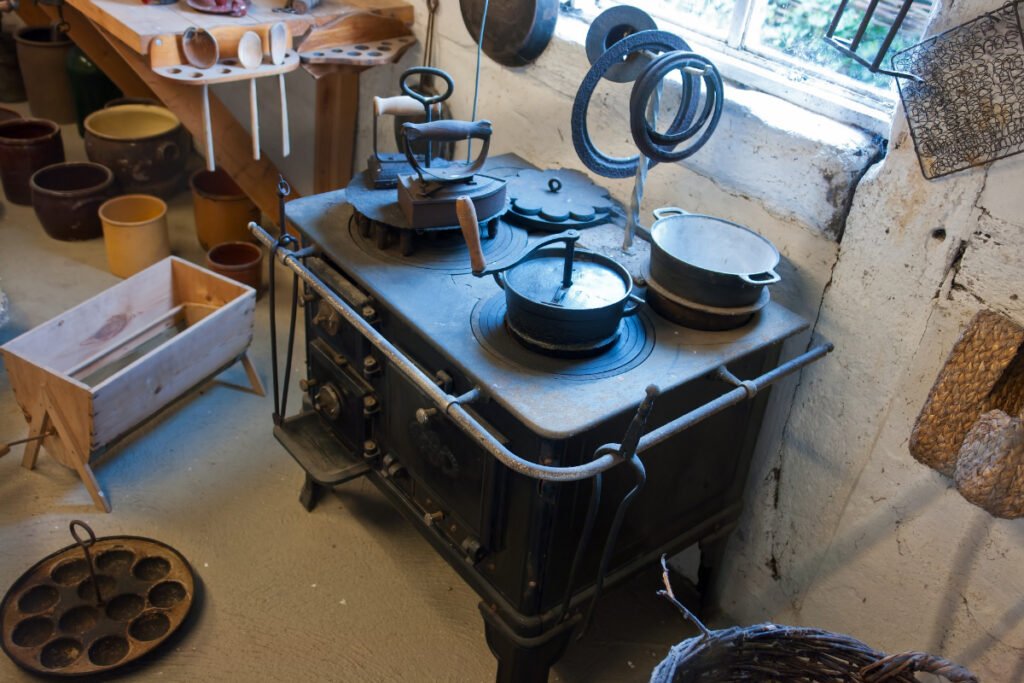We all have wood stoves at home, right? Some sit concealed, while others are shiny. But what if your stove still has those old, rusty, carved bodies? Well, in that case, it’s a jackpot, because your stove might be antique, attracting collectors worldwide!
But how do you know at what price to sell it? And how do you spot its antique features? Worry not! Today, I will help you with the cues for easy antique wood stove identification and pricing. So, let’s begin!
Key Takeaways
- Rectangular, cuboidal, and square-based stoves are highly valuable. The limited-edition white or light-blue stoves also fetch good returns at auction.
- It’s always the branded or European stoves that are the most precious. And you can check the same by verifying the logos from the doors, seams, and patent numbers.
- You can get Franklin, Charter, Pot-belly, Parlor, or Step-top wood stoves for an old make. Stoves with nickel or brass bases are also highly collectible.
- Choose stoves with metal or stone sidings, racks, and discolorations for an old make.
What Do Antique Wood Stoves Look Like?

Most antique wood stoves have a cubical cast iron or steel body and an enclosed fire chamber and chimney. They might even have some shelves, ledges, or carved shutters and legs that elevate their valuation by 3 – 4%.
But this isn’t all! Below are more features that help identify rare wood stoves better:
- Rectangular, engraved shutters, and high-relief inlay carvings
- Round stove bases and nickel-plated squarish vents
- Embossed model letters and manufacturing years for easier tracking
- Bulbous or tapering crowns with handles
- 6 – 10 ceramic cooking plates and grills
- Thicker stove walls and long, spindled legs
History & Evolution of Wood Burning Stoves
Wood stoves evolved with the making of the ‘Jamb stoves’ or ‘Fireplates’ in 1728. These German-made plates had arched sides and meshed shutters to let out heat. They also had a thick brick base to save the floor from burning.
Then, Franklin stoves, a colonial startup, built the first commercial stoves in the 1740s. These stoves had a 3-sided iron box with thick exhaust ducts. And they worked on a siphon and baffle system that controlled the fumes and heat. So, they fetch good returns today.
However, manufacturers started experimenting with portable stoves and air controllers in the 1900s. So, gas stoves became minimal but had fine-cast walls with etched logos and inlay designs. And these branded kilns are easier to track and yield high returns.
6 Types of Antique Wood Stoves & Their Values
Vintage fire stoves have different shapes, materials, and colors per their age. But they also have some key types that decide their primary valuation. Below are the six main types of old wood stoves for better identification:
1. Franklin Wood Stoves (1700s)
Franklin stoves are freestanding, cast-iron fireplaces with four legs and carved bi-fold doors. They have a curved, U-shaped grill and a heated baffle that radiates heat from all sides. Since these old stoves are large and heavy, they have a greater valuation of up to $1700.
2. Charter Oak Stoves (1800s)

Charter Oak stoves are thin and light Eisenglass or mica stoves. They usually have silver sides and oak doors, but older ones might have yellow walls and mesh frames. But since they are soft and brittle, they have a lower value of $400 – 500.
3. Pot Belly Fire Stoves (1850s)

As the name suggests, pot belly stoves are small, spherical stoves with a pot-like base and siphon top. They have four legs, 2 – 3 cooking plates, and brown or black walls. Newer pot belly stoves are mostly built in cast iron or steel, but old ones might have a nickel frame too.
Pot belly stoves have detachable surfaces, polished screws, and better ventilation. But they have no viewing windows or fire-control options and might cause a mishap. So, they are low-valued and cost $400.
4. Parlor Wood Stove (1870s)

Parlor wood stoves are easily identified due to their small size and ornate carvings. They are not only luxurious and Victorian but have black walls and clear glass doors. And since they have cupped tops and extra storage shelves, they are also more functional.
But, these stoves are very small and cannot heat the entire room. So, they have low demand and valuation between $70 – 100.
5. Wood Cook Stoves (1900s)

If you see a small, multipurpose stove with 2-3 burners, it’s a wood cook stove. Made after the Industrial Revolution, this one can cook and bake simultaneously. Plus, most have thin sides, shutters, and grills, valuing $100 – 150.
6. Step-top Wood Stove (1900s)
Step-top stoves are minimal cast-iron stoves with a double-story profile. They feature four plates at the lower level but natural exhausts on the upper step. Thus, they are very space-efficient and ergonomic.
Step-top stoves are comparatively new and minimal in appearance. However, they are highly valued at $200 – 300 because of their unique design and solid oak wood legs.
7 Factors to Identify & Value Antique Wood Stoves
Old wood stoves are precious and fetch $400 – 500, depending on their age, brand, and materials. Generally, rectangular, cast-iron stoves are high-valued, whereas cubical gas stoves are affordable.
As we saw, antique stoves’ values change with the type. But did you know that even the age, shape, and materials of the wood heater impact the cost? Let’s see how!
1. Old Stove’s Date & Age

Vintage stoves from the 1700s are quite old and, hence, the most precious. And their pricing escalates more if they have nickel or floral motifs. Similarly, stoves from the 1800s are precious due to their unique shapes and systems.
In contrast, machine-made stoves from the late 1950s are mass-produced and readily available. And since they are small and low-power, they have a lower valuation of $50 – 70.
Here’s a checklist to track the stove’s age:
How Does a 1700s Stove Look?
Check if your fire stove has cubical, bi-fold doors and tripod legs. If yes, it’s from the 1700s. You can even look for 30-inch brick bases and exhausts with them. Also, check if they have a cast iron side plate. If yes, price them for $1000 – 2000. Otherwise, $1000 – 1200 is good!
How Do You Check If Your Stove Is from the 1800s?
Check if your stove has plain cast iron walls, flat bases, and baffles. Many of them might even have a central airflow and baffle system. Plus, you’ll also see minimal but branded designs that hike the costs to $500 – 800.
How Do You Spot Old Stoves from the 1900s?
Look for lightweight, portable, and mass-produced models to spot these! They are not fancy but have a unique patent number or logo that tracks them easily. But since they have low demand, they have a low value of up to $80.
Here are some common patent numbers for quick reference:
| Year | Stove Age | Patent Number | Location | Manufacturer | Valuation |
| 1851 | 172 years | 7973 | Albany, New York | Franklin | $550 – 650 |
| 1896 | 127 years | US559236A | Ohio | Van Wie Burners | $400 – 500 |
| 1923 | 100 years | US1722411A | America | Dilworth Gas Stoves | $200 – 300 |
Discuss the old antique wood stove’s patent number with the United States Patent Office to understand its history and value before purchase.
2. Antique Stove’s Shape
If you want a wood stove to heat a larger area, then the 18th Century Victorian stoves are best! Simple and rectangular, most have tapering swindle legs and bent inlay footrests.
But if you want short, medium-sized stoves, pick the boxed stoves! And, if you are eyeing returns, what’s better than the 1800s curved and hinged stoves?
Want to know how each shape impacts the value of your antique wood-burning stoves? Check it out below!
| Shape of the Stove | Average Valuation |
| Rectangular, Step Stove | $7000 – 7500 |
| Cuboidal, Wardrobe-like stove | $3000 – 3400 |
| Cylindrical or Drum-shaped | $1000 – 1200 |
| Barrel Shaped | $400 – 450 |
| Cubical or Squarish | $200 – 250 |
Pick stoves with cubical steel handles and extra drawers for a high value.
3. Old Stove’s Color
You must be familiar with black and gray stoves! But antique wood stoves had so many colors – white, light blue, and red. Of these, oxidized and exclusive colors like white and azure are precious. But the new, galvanized colors like green and slate gray are cheaper!
Check the table below for each wood stove’s color and value:
| Fire Stove Color | Manufacturing Year | Age | Valuation |
| Gray, Black, or Charcoal | 1700 | 322 | $750 – 850 |
| White, Light-blue or Azure | 1800 | 222 | $700 – 720 |
| Light Green or Red | 1850 | 172 | $600 – 650 |
| Yellow, Cream or Beige | 1870 | 152 | $500 – 600 |
| Fawn, Rust or Metallic Brass | 1870 | 152 | $400 – 500 |
| Olive Green or Slate Gray | 1920s | 102 | $250 – 280 |
Never buy Bold red or Canary yellow kilns, as these mark a new, low-value galvanized finish.
4. Branding
Branded or factory-made stoves from the 18th century fetch high values at any auction. These durable stoves have thick, designer walls and logos that track their age and value. And they might have polished handles and plates that hike their cost further.
Generally, these stoves are built in Britain or Europe and have a proper tax label for imports. And you can even check the door’s metal plate, sides, or back for other trademarks and billing receipts.
Old wood stoves with etched brand logos are precious and hike costs by 2-3%. And those with intact tax receipts and labels are even more valuable and offer a 4-5% return.
Here are some popular vintage stove brands for reference:
| Stove Name | Manufacturer | Year | Region | Valuation |
| Cylindrical Cast-Iron Fuel Stove | French Rosieres | 1900 | France | $450 – 500 |
| Fisher Wood Stove | Grandma Bear | 1980 | America | $3500 – 3700 |
| Oven Fireplace Stove | Cornish Kitchen Range | 1900 | Britain | $4000 – 4200 |
| Double Oven Stove | Wedgewood | 1950 | California | $2000 – 2200 |
| Parlor Stove | Columbus Ironworks | 1900 | Georgia | $1600 – 1700 |
Never buy gas-pipe or valved stoves, as these might be low-value, first-edition models.
5. Rarity
Exclusive, painted stoves are always valuable, irrespective of their condition or capacity. These stoves are usually branded and might have shiny gold or stone carvings at the top. Or, they might be unique and custom-made as per different kitchen sizes.
Of these, you’ll get the best returns for royal stoves with less than 1000 pieces! Next are the fancy, Victorian pieces, with about 2000 pieces in circulation. In contrast, a company-made, mass-produced piece will be cheaper! So better stay away from such thin, portable stoves.
Here are some rare fire stoves to collect:
| Stove Name | Manufacturer | Year | Auction Site | Valuation |
| Column Stove | Geer & Cox | 1830 | Rare Antique Stoves | $2000 – 4000 |
| Victorian Parlor Stove | Stewart Oak | 1900 | Live Auctioneers | $400 – 450 |
| Box-style Cookstove | Great Western Stove Company | 1903 | eBay | $1300 – 1500 |
| Cylinder Victorian Stoves | Bonny Oak | 1900 | eBay | $400 – 500 |
Look out for rare, step-top or Victorian stoves with brass carvings and handles for high returns.
6. Stove Materials

Vintage stoves from the 1700s – 1800s have cast-iron or alloyed steel sides. In contrast, 18th-century stoves are made from mica or Eisenglass. So they are more flexible, lighter, and insulating. They are also thin with a shiny wax polish that raises their valuation to $800.
The later 19th-century stoves can be made from soapstone, oak wood, or galvanized iron. So, they are heavy, stationary, and have simple forms and minimal designs. But these new stoves are commonly available and have a lower valuation of $50 – 100.
| Stove Material | Year | Average Valuation |
| Cast- Iron or Alloyed Steel | 1700 | $1400 – 1500 |
| Mica or Eisenglass | 1800 | $800 – 950 |
| Soapstone | 1900 | $60 – 80 |
| Sheet Metal and Baked Enamel | 1850s | $80 – 150 |
| Wood or Wood Pellets | 1900 | $70 – 120 |
| Galvanized Steel or Zinc | 1920s | $50 – 70 |
Pick stoves with smaller fire windows and double burners for an old make.
7. Heat Source

Old wood stoves with upward exhaust vents, metal grates, and ash pans value from $100 – 120. In contrast, modern coal stoves with under-floor vents and fire controllers are delicate and cheaper.
And factory-made gas-line stoves are more affordable but have a low demand for antiques.
Never slide your antique stove against the floors, as it could loosen their connections and start a fire.
What Can You Do with an Antique Wood Stove?
You can use antique wood stoves to add a lovely vintage feel to your fireplaces or kitchen corners. For a medieval ambiance, you can also place them against your patios or outdoor decks. Or, you can use them to ignite smaller campfires during events.
Where Can I Sell My Antique Wood Stove?
You can sell your antique wood stoves on e-commerce websites like eBay, Stovelist, or Etsy. Or, you can visit the local antique shops and auctions and put your item for a bid.
Vintage wood stoves are great new-classical decor tools and fetch good returns for your fireplace. But you can pick gray, cuboidal stoves with brass handles for high prices. And various other factors like patents and brands will help you age and value the product easily.
Antique wood stoves can also be a great room heater if paired with burning oak wood and a kiln. So, you can grab an antique rocking chair and curate a quiet, relaxing corner for yourself. But how do you identify and value old rocking chairs? Let us find out!
Note: This article is intended for informational, educational, and entertainment purposes only. Some images are illustrative and may not represent actual brands, products, or related entities. All trademarks, product names, brand logos, packaging, and other intellectual property referenced remain the exclusive property of their respective owners. Any brand mentions or references are provided solely for descriptive and educational context and do not imply any formal or commercial association.










